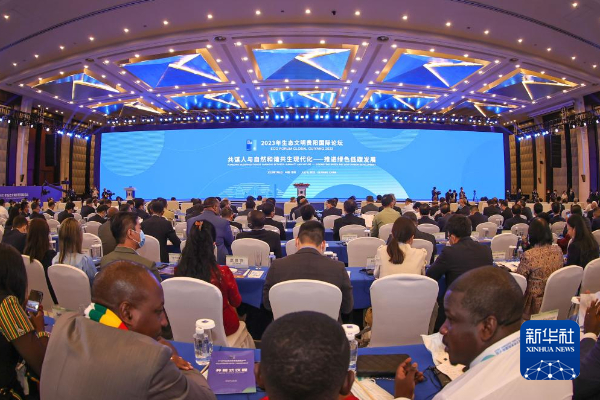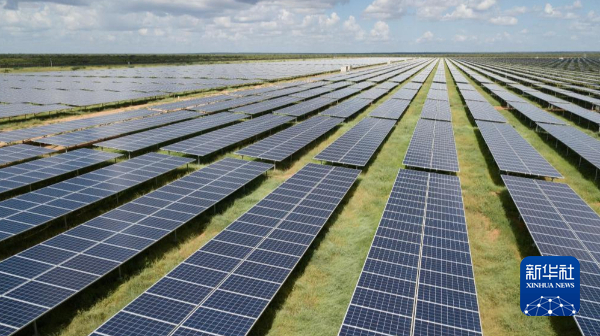


Coinciding with the 10th anniversary of the " the Belt and Road (BRI) " initiative, the Eco Forum Global Guiyang 2023 was held on July 8th - 9th, with the theme of "Implementing Global Development Initiatives, Promoting Green and Low-Carbon Development". The topic of "building a green ‘Belt and Road’ " has become a hot topic of discussion.
"Since the launch of the BRI, China has actively promoted the establishment of a cooperative mechanism for green and low-carbon development, including the signing of a memorandum of understanding with the United Nations Environment Programme (UNEP) on building a green Belt and Road, the launching of the BRI Partnership Initiative for Green Development with 31 co-constructing countries, and the establishment of the BRI Energy Partnership with 32 co-constructing countries.

Opening ceremony of Eco Forum Global Guiyang 2023 [photographed on July 8th, by Yang Wenbin, Xinhua News Agency]
“China is the world leader in nearly all technologies critical to the green shift…The Belt and Road program provides a great opportunity for China to share its technologies with other developing countries.” Erik Solheim, Former Executive Director of the UN Environment Programme, President of the Belt and Road Green Development Institute, said.
From the sharing of experience in pollution prevention and ecological restoration to the promotion of green infrastructure construction, from green production capacity and equipment manufacturing cooperation to the development of green finance and green trade systems, China and the BRI countries are taking practical measures to build the Belt and Road into a green road.
At present, China has set up the Belt and Road International Research Institute for Green Development and built the Belt and Road Ecological and Environmental Protection Big Data Service Platform to help BRI countries improve their green development technology and environmental governance capacity. Hydroelectric power stations, photovoltaic power stations, wind power stations ...... With the active participation of Chinese enterprises, a number of clean energy projects have sprung up in BRI countries, boosting the local green and low-carbon development. Among them, the largest photovoltaic power plant in East Africa constructed by Chinese enterprises, the 50 MW photovoltaic power plant in Garissa, Kenya, was officially put into operation on the same day.

Solar panels of 50 MW photovoltaic power station in Garissa, Kenya [photographed on December 13th, 2019, by Xie Han, Xinhua News Agency
"The Karot Hydropower Project in Pakistan can meet the daily electricity demand of about 5 million people" "It can save about 1.4 million tce per year" Liu Zi, Deputy General Manager of China Three Gorges Corporation (CTGC), mentioned in the interview.
The project, invested and constructed by CTGC, is a key project of the China-Pakistan Economic Corridor, and has been officially connected to the grid in June 2022 to generate electricity. In addition to the Karot Hydropower Project in Pakistan, CTGC has completed or operated many projects in BRI countries, including the Meerwind Offshore Wind Farm in Germany, the Chaglla Hydroelectric Power Plant in Peru, and other clean energy projects.
"In the future, China can carry out joint research and exchange training around high-efficiency and low-cost, renewable energy power generation, advanced nuclear power, smart grids, hydrogen energy, water energy, universal utilization and storage of carbon dioxide, etc., to strengthen green R&D capacity building in the BRI countries. "said by Liu Shijin, former deputy director of the Development Research Center of the State Council (DRC)
According to statistics, the Belt and Road Initiative International Green Development Coalition, which was established at the first Belt and Road Forum for International Cooperation, has attracted more than 100 organizations to become its partners.
Additionally, the Guiyang Declaration was also issued at the Forum, which proposes a comprehensive approach centered around ecological civilization to establish and improve the natural protected area system, promoting global biodiversity conservation and human well-being. It emphasizes strict protection measures to ensure intergenerational inheritance, advocates for government-led initiatives with multi-stakeholder participation, and aims to enhance the diversity, stability, sustainability of ecosystems. The ultimate goals are to advance the high-quality construction of the natural protected area system, strengthen the supply capacity of ecological products, and safeguard ecological security.
The release of the Guiyang Declaration showcased China's approach in realizing the harmony between humanity and nature, contributing to global ecological civilization construction and green development.
Source:<http://gz.news.cn/20230710/e78ab65a1bf44affb1238df0b4aebd8d/c.html <http://www.igsnrr.cas.cn/news/kyjz/202104/t20210430_6005902.html>
Edited and translated by Chen Xiao